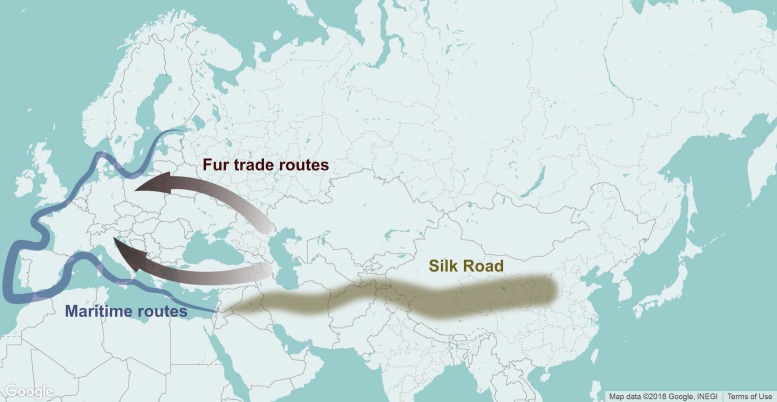In their letter, Barbieri et al. (1) cite valuable works on human ectoparasite transmission well known to us. Indeed, we previously tested alternatives to the rat/rat–flea mechanism of transmission and found that a model with human ectoparasites was the most appropriate in Europe (2, 3) where there were no known wild-rodent reservoirs (4). Thus, we agree with Barbieri et al. (1). However, for our most recent paper (5), we did not have the genetic information to address the question of transmission modalities. At our current level of knowledge, we can only interpret the genetic data in a phylogenetic context and explore the routes taken by plague to reach Europe in light of the historical information.
Contrary to what Barbieri et al. (1) argue, however, the fur trade routes are not exactly the Silk Road, as we know from the work of Martin (6). First, the Silk Road system lies south of Bolgar and Novgorod, the two centers that controlled fur importation from Russia in the 14th century. In fact, Novgorod was connected to the northern trade routes of the Hanseatic League (7, 8). Second, by the first half of the 14th century, after the devastating conquest by the Golden Horde, Bolgar, which imported fur from the region referred to as the “Land of Darkness” (see ref. 6), was forced to withdraw from the caravan routes to Caffa and Khwarezm, and instead export its fur to Sarai by ship along the Volga (6). Sarai was a thriving market that exported goods on the Mongols’ east–west commercial routes, which connected also to the Silk Road. From Sarai, fur was exported to the Black Sea, but also to the East, Middle East, and India. In Martin (6), Ibn Battuta described the fur from the Land of Darkness: “Sable is cheaper than ermine… One of the characteristics of these skins is that they have no vermine; and so the princes and nobles of China attach them to their coats around the neck. The merchants of Persia…wear them the same way.”
It is in this way inspiring to think that fur itself may have contributed to the spread of plague (Fig. 1), because (i) a variety of other fur (“vair-skin, ermine, fox, sable, fitch, marten, wolfskins, and deerskins”) from surrounding regions was possibly introduced to Sarai and traded in Black Sea ports (6); (ii) the region close to Sarai is a plague reservoir; (iii) furs could have contained ectoparasites or vermin; and (iv) many iconographic representations show that people wore fur. This hypothesis, along with the one about Bactrian camels and dromedaries that Barbieri et al. (1) suggest, or a third hypothesis, namely that hunters spread plague (as in Manchuria in 1910–1911), remain working hypotheses, which go beyond the present scope of Namouchi et al. (5).
Fig. 1.
Schematic representation of multiple waves of introductions of plague involving different land and maritime trade routes. The two arrows reflect the involvement of the fur trade routes in the dissemination of Yersinia pestis into Europe from the Land of Darkness. The blue line represents the maritime routes. The dark line represents the Silk Road.
As for today, to properly address these hypotheses using genetic information, we need more ancient DNA samples distributed along well-known trade routes and neighboring areas, as well as a greater representation of historical records. Regardless, it seems clear that human movements were important for the spread of plague from Asian reservoirs to Europe, as they are for many diseases today.
Footnotes
The authors declare no conflict of interest.
References
- 1.Barbieri R, et al. Plague, camels, and lice. Proc Natl Acad Sci USA. 2019;116:7620–7621. doi: 10.1073/pnas.1901145116. [DOI] [PMC free article] [PubMed] [Google Scholar]
- 2.Dean KR, et al. Human ectoparasites and the spread of plague in Europe during the Second Pandemic. Proc Natl Acad Sci USA. 2018;115:1304–1309. doi: 10.1073/pnas.1715640115. [DOI] [PMC free article] [PubMed] [Google Scholar]
- 3.Dean KR, Krauer F, Schmid BV. Epidemiology of a bubonic plague outbreak in Glasgow, Scotland in 1900. R Soc Open Sci. 2019;6:181695. doi: 10.1098/rsos.181695. [DOI] [PMC free article] [PubMed] [Google Scholar]
- 4.Schmid BV, et al. Climate-driven introduction of the Black Death and successive plague reintroductions into Europe. Proc Natl Acad Sci USA. 2015;112:3020–3025. doi: 10.1073/pnas.1412887112. [DOI] [PMC free article] [PubMed] [Google Scholar]
- 5.Namouchi A, et al. Integrative approach using Yersinia pestis genomes to revisit the historical landscape of plague during the Medieval Period. Proc Natl Acad Sci USA. 2018;115:E11790–E11797. doi: 10.1073/pnas.1812865115. [DOI] [PMC free article] [PubMed] [Google Scholar]
- 6.Martin J. The Land of Darkness and the Golden Horde. The fur trade under the Mongols XIII–XIVth centuries. Cah Monde Russe Sov. 1978;19:401–421. [Google Scholar]
- 7.Ostrowski D, Poe MT, editors. Portraits of Old Russia: Imagined Lives of Ordinary People, 1300–1725. Routledge; London: 2011. [Google Scholar]
- 8.Veale EM. 2003 The English Fur Trade in the Later Middle Ages (London Record Society, London), 2nd Ed, Vol 38. Available at https://www.british-history.ac.uk/london-record-soc/vol38. Accessed March 18, 2019.



